
European Union Agency for Railways (ERA)
The European Union Agency for Railways (ERA), headquartered in Valenciennes, in the North of France, is a pivotal body dedicated to the advancement and harmonization of the railway sector within the European Union. Established to ensure the development of a safe, modern, and integrated European railway system, ERA plays a crucial role in shaping the future of rail transport across the continent.
Mission Statement and Vision
Vision
ERA’s Vision aligns closely with the objectives of the European Green Deal, highlighting rail’s potential to become the backbone of a multimodal transport and mobility system in Europe. This vision emphasizes several key aspects:
- Sustainability: Rail is recognized for its high environmental performance, characterized by high energy efficiency and low externalities. The vision underscores the importance of rail as a sustainable mode of transport.
- Safety: Maintaining a high level of safety performance is integral to ERA’s vision, ensuring that rail transport remains one of the safest modes of travel.
- Integration: The vision encapsulates the idea of moving from a fragmented system to a cohesive network. The phrase “without frontiers” reflects ERA’s commitment to establishing a seamless European network of transport that leverages the strengths of various transport modes.
By integrating rail fully into the broader transport and mobility patterns of Europe, ERA aims to foster a transport system that is both environmentally friendly and highly efficient.
FEDECRAIL as a Representative Body in the European Union Agency for Railways (ERA)
FEDECRAIL, the European Federation of Museum and Tourist Railways, holds a significant position as a representative body within the European Union Agency for Railways (ERA). As a representative body, FEDECRAIL plays a crucial role in ensuring that the interests and perspectives of museum and tourist railways are considered in the regulatory and developmental processes overseen by ERA.
Role and Importance of FEDECRAIL as a Representative Body
Advocacy and Representation
- Voice for Members: FEDECRAIL advocates on behalf of its members, which include various museum and tourist railways across Europe. It ensures that their unique needs and challenges are addressed in ERA’s policies and regulations.
- Policy Influence: By participating in ERA’s consultations and working groups, FEDECRAIL influences the development of policies that impact the heritage rail sector, promoting favorable conditions for its preservation and growth.
Consultation and Feedback
- Expert Input: FEDECRAIL provides expert opinions and feedback on proposed regulations, ensuring that the specific requirements of heritage railways are taken into account. This includes aspects related to safety, interoperability, and sustainability.
- Collaboration with ERA: FEDECRAIL works closely with ERA to ensure that the regulatory framework supports the continued operation and development of museum and tourist railways.
Information Dissemination
- Keeping Members Informed: FEDECRAIL disseminates important information regarding regulatory changes, best practices, and developments within the rail sector to its members. This helps them stay compliant and informed about new opportunities and challenges.
- Resource Sharing: By sharing knowledge and resources, FEDECRAIL helps its members navigate the regulatory landscape effectively.
Promotion of Heritage Railway
- Highlighting Cultural Value: FEDECRAIL emphasizes the cultural and historical importance of museum and tourist railways, ensuring that their value is recognized in the broader context of the European rail network.
- Supporting Sustainability: FEDECRAIL advocates for sustainable practices within the heritage rail sector, aligning with ERA’s vision of a sustainable and safe transport system.
Coordination and Collaboration
- Unified Approach: FEDECRAIL coordinates efforts among its members to present a unified approach to common challenges and opportunities. This collective effort strengthens their position within the regulatory environment.
- Networking: By facilitating networking and collaboration among heritage rail operators, FEDECRAIL promotes the exchange of ideas and best practices.
Conclusion
As a representative body within the European Union Agency for Railways, FEDECRAIL plays an essential role in bridging the gap between heritage railways and the regulatory framework governing the European rail sector. Through advocacy, consultation, information dissemination, and promotion of heritage values, FEDECRAIL ensures that the unique needs of museum and tourist railways are considered, contributing to a diverse and culturally rich European railway network.
What is a Representative Body?
A representative body within the context of the European Union and its agencies like ERA refers to an organization or group that represents the interests and viewpoints of specific stakeholders or sectors within the railway industry. These bodies play a crucial role in the regulatory and development processes by providing insights, feedback, and recommendations from the perspectives of those they represent. Here are some key functions of a representative body:
- Advocacy: Representing the interests of its members in discussions and negotiations with regulatory bodies and other stakeholders.
- Consultation: Participating in consultations and working groups to provide expert opinions and industry perspectives on proposed regulations, policies, and standards.
- Information Dissemination: Keeping members informed about regulatory developments, best practices, and other relevant information.
- Coordination: Facilitating collaboration and coordination among different stakeholders within the railway sector to ensure a unified approach to common challenges and opportunities.
ERA 2022 Activities
In 2022, ERA continued to focus on several core areas to advance its vision and mission:
- Safety and Interoperability: Working on enhancing the safety standards and interoperability of the European railway network to ensure a seamless and secure rail transport system.
- Digitalization: Promoting the adoption of digital technologies in the railway sector to improve efficiency, reliability, and passenger experience.
- Sustainability: Supporting initiatives and policies that aim to reduce the environmental impact of rail transport, in line with the European Green Deal.
- Harmonization: Striving to harmonize railway operations across member states to create a truly integrated European rail system.
By focusing on these areas, ERA aims to make rail transport a cornerstone of Europe’s sustainable and efficient transport network, ensuring that it meets the future needs of mobility and logistics.


